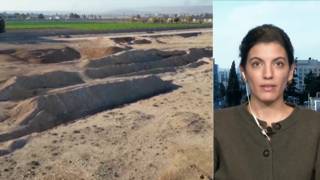
Related
Guests
- Neta Crawfordco-director of the Costs of War Project and a professor of political science at Boston University.
On the 10th anniversary of the U.S. invasion of Iraq, we look at a massive new report by a team of 30 economists, anthropologists, political scientists, legal experts and physicians about the Iraq War’s impact. “The Costs of War” report found the total number of people who have died from the Iraq War, including soldiers, militants, police, contractors, journalists, humanitarian workers and Iraqi civilians, has reached at least 189,000 people, including at least 123,000 civilians. Financially, the report estimates a cost to U.S. taxpayers of $2.2 trillion, a figure that could one day approach $4 trillion with the interest accrued on the borrowed money used to fund the war. We’re joined by the report’s co-author, Neta Crawford, professor of political science at Boston University. [includes rush transcript]
Transcript
AARON MATÉ: It was 10 years ago today that the U.S. invaded Iraq on the false pretext that Saddam Hussein was hiding weapons of mass destruction. The attack came despite worldwide protest and a lack of authorization from the U.N.—from the U.N. Security Council. This was how Democracy Now! began our broadcast on March 19th, 2003.
AMY GOODMAN: U.S. and British forces have moved into the demilitarized zone straddling the Iraq-Kuwait border in preparation for an attack on Iraq. Reuters is reporting convoys of U.S. and British tanks and fighting vehicles have been snaking through sandstorms in the Kuwaiti desert heading towards the Iraqi border. One Iraqi has already been shot dead off the coast of Kuwait. Less than 12 hours remain before the U.S. ultimatum to the Iraqi president, Saddam Hussein, to flee reaches its deadline at 8 p.m. Eastern Standard Time tonight. Baghdad has rejected it. Meanwhile, Saudi Arabia has proposed for the first time that President Saddam Hussein should go into exile as a last-ditch bid to avert war.
AARON MATÉ: Well, later that evening, a Pentagon official reported cruise missiles had been fired in Iraq as part of a, quote, “decapitation attack” aimed at killing Saddam Hussein. Then, around 5:30 a.m. Baghdad time, 9:30 p.m. Eastern time, air raid sirens were heard after the U.S. deadline for Saddam to step down had passed. Within the hour, President George W. Bush gave a nationally televised speech from the Oval Office announcing the war had begun.
PRESIDENT GEORGE W. BUSH: American and coalition forces are in the early stages of military operations to disarm Iraq, to free its people and to defend the world from grave danger.
AMY GOODMAN: Six weeks later, President Bush would stand under a banner reading “Mission Accomplished” and declared an end to major military combat operations in Iraq. But Operation Iraqi Freedom, as he called it, would lead to an almost nine-year U.S. military occupation of Iraq.
We begin the show today looking at the costs of war. That’s the title of a massive new report by a team of 30 economists, anthropologists, political scientists, legal experts and physicians about the Iraq War’s impact. In one of its striking tallies, it found the total number of people who have died from the Iraq War, including soldiers, militants, police, contractors, journalists, humanitarian workers and civilians, has reached at least 189,000 people, including at least 123,000 civilians. The report also looks at the ballooning expenses of veterans’ benefits and medical treatment.
For more, we’re joined by its co-author, Neta Crawford, co-director of the Costs of War Project, professor of political science at Boston University, where she’s joining us from now.
Professor Crawford, welcome to Democracy Now! Lay out the costs of the Iraq War.
NETA CRAWFORD: The costs, I think, could be put into basically three baskets. The first is the short-term budgetary costs. Second are the immediate human toll, which you’ve just mentioned: about 190,000 people killed, and then there are many wounded. And then there’s the long-term economic consequences.
Just think about the budgetary costs. The Bush administration told us that the war would be, oh, maybe $50, $60 billion. And the person, Lawrence Lindsey, who gave a higher estimate of $100 to $200 billion, was told to find other work. So, what we see now is the cost of the Iraq War is $1.7 trillion so far, and into the future more like $2.1 trillion, including those long-term benefits for veterans’ care. So that’s in the one basket.
And in the second basket, the human toll, that 130,000 or so civilians actually is probably an undercount, maybe by a factor of two, because what’s recorded is what Iraq Body Count notes—they keep a tally of press reports and official releases of civilian casualties—but we know that the Iraqi Ministry of Health and the morgues have been told not to release all the war’s dead. And then, many people are wounded, of course. The wounded are probably in a one-to-one—at least a one-to-one ratio in Iraq, so 130,000 or maybe many more than that seriously wounded.
And then, if you think about the long-term costs, we can get into that, but they’re substantial, as well.
AARON MATÉ: And, Professor, the ways in which people have died? Obviously, you have people being killed through bombings, direct warfare, but you also talk about the indirect toll through the health crisis in Iraq.
NETA CRAWFORD: Right. The indirect deaths, or excess death, as some demographers call it, are caused when infrastructure is destroyed, either intentionally or unintentionally. So, when bombing takes out water treatment facilities or sanctions before the war did not allow the repair of material that was vital for health, like the healthcare infrastructure, and then that’s exacerbated with the war, what you see is that immunization rates go down, infant mortality goes up. You see diseases and injuries which could have been taken care of medically inside Iraq not taken care of.
Now, many Iraqis have tried to seek treatment in the region, in Syria—they’ve had to leave Syria now—Jordan, Lebanon. They’ve—even as far away as India. But the getting treatment is difficult and expensive, as well. So, there’s a huge healthcare crisis there. Many doctors have left, not to return. So right now in Iraq there are 22,000 physicians for a population of over 31 million. There are 84 psychiatrists for that same population, a population that is traumatized by many, many years of war and, before that, by sanctions and another war.
AMY GOODMAN: Then there’s the U.S. soldiers—the U.S. soldiers who went there, the thousands who were killed and the soldiers who come back wounded. Can you talk first about the deaths of U.S. soldiers and also those who came back physically ill? For example, respiratory illnesses, like—almost like we saw in the Gulf War.
NETA CRAWFORD: Well, the illnesses for the—well, let’s just first begin with the deaths of U.S. soldiers: 4,488 soldiers died in the Iraq War. That is of all kinds of causes—IEDs, which we’re familiar with, but also being crushed by their own vehicles in traffic accidents. They died in the many ways that people die in war—shot and so on. Many come back wounded, complex injuries, more complex than in previous wars because of the higher survival rates in the field.
And what you also see, which you’ve just mentioned, are chronic respiratory problems. So, they have something called constrictive bronchiolitis, which is a disease caused by small particles, 2.5 to 10 microns, embedded inside the lungs of these returning soldiers. And that’s caused by dust and burn pits. So this particulate matter gets inside the soldiers’ lungs, and it decreases their ability to exercise. They’re no longer elite athletes as they were when they deployed. Now they’re having difficulty running a mile or two.
And these soldiers also come back with higher rates of heart problems. And more than a third of them who have become subject to the Veteran Administration’s care are seeking help for mental disturbances.
AMY GOODMAN: Which brings us to suicide. In August [May 16, 2012], we spoke to Iraq War veteran Aaron Hughes about suicides in the military.
AARON HUGHES: Every day in this country 18 veterans are committing suicide. Seventeen percent of the individuals that are in combat in Afghanistan, my brothers and sisters, are on psychotropic medication. Twenty to 50 percent of the individuals that are getting deployed to Afghanistan are already diagnosed with post-traumatic stress disorder, military sexual trauma or a traumatic brain injury. Currently one-third of the women in the military are sexually assaulted. It’s clear that these policies of the global war on terror has had a profound effect on the military, my brothers and sisters, while simultaneously perpetuating a failed policy. And unfortunately, we have to live with that failed policy on a daily basis, and we don’t want to be a part of that failed policy anymore.
AMY GOODMAN: Iraq War veteran Aaron Hughes talking about suicides in the military. This emotional cost, the deaths that relate to suicide in this country from soldiers returning, veterans, and also the costs of veteran care, Professor Crawford?
NETA CRAWFORD: Well, 349 active-duty soldiers committed suicide last year. And then there are the veterans, who have tried to take their life and not succeeded, and the many who succeed.
AMY GOODMAN: Active-duty soldiers. Active-duty soldiers. That’s more than a soldier a day, just active-duty—that doesn’t count veterans—every day, close to.
NETA CRAWFORD: Well, 349.
AMY GOODMAN: Close to.
NETA CRAWFORD: Yes, almost a soldier a day, that’s right. And these active-duty soldiers are lucky: They have available to them the resources of the Army, the Marine Corps, the Air Force, the Navy, trying to help them not commit suicide. And unfortunately, those efforts are not bearing fruit. That’s a higher suicide rate than the year before and a higher suicide number than the year before that. So, what we see is that despite the resources that are being put into helping the soldiers who have returned from Iraq and Afghanistan, it’s not bearing enough fruit.
And then what you’ll also see is, for the veterans, it’s possible that the number of suicides will increase over time, because trauma is cumulative. There was a study in World War I that found that if you had somebody out in the field long enough, everyone would return with what they then called shell shock, or now post-traumatic stress. So everyone is vulnerable. And so, the resources that you need to put there are tremendous.
AARON MATÉ: And, Professor, overall, your report cites a figure of $2.2 trillion as the cost to U.S. taxpayers for the Iraq War, but you actually say that the costs could be higher because so much of that funding was borrowed, so there will be more money to pay because of interest.
NETA CRAWFORD: That’s right. When you—it’s like buying a house. And in this case, we bought a house that never really functioned, and we have repair costs. But just talk about the interest on our mortgaged war, it will be several trillion dollars over time. Now, the United States has many policy options available to deal with the interest on borrowing for the war, which could reduce the several trillion, but the trillions that the United States will pay in interest, if we don’t, for instance, get engaged in a war tax, will exceed the costs of the war.
AMY GOODMAN: What most surprised you, Professor Crawford, about the Costs of War report?
NETA CRAWFORD: Well, there are so many things we weren’t able to include. For example, we didn’t look at the cost to the allies. The U.K. and Germany have spent $20 billion apiece, probably, but they don’t know, themselves, on the wars in Iraq and Afghanistan with the United States. So the U.S. has sort of been subsidized by its allies. So, we didn’t include some of these larger costs. And, of course, we didn’t—we weren’t able to get to some of the costs in the region. So what struck me was how much we don’t know yet about the cost.
The second thing that always strikes me is the sort of indifference to life that one sees, both the life in Iraq, how we don’t know exactly how many people have died in Iraq, and how we still don’t know and haven’t put the resources into repair to decrease the indirect deaths that will follow over the years from this war—just the indifference, or maybe perhaps a lack of understanding of the consequences of war.
AMY GOODMAN: You—
NETA CRAWFORD: And as always—yes, go ahead.
AMY GOODMAN: You talk about the costs of war. What about who profited?
NETA CRAWFORD: Well, some corporations made out pretty well. Lockheed, you know, the ones we heard about during the war, they did very well. Contractors, the human contractors themselves, though, were wounded and killed at high rates. So if you worked for one of the contractors, then you might not—you might feel that your salary didn’t compensate for the stress that you’re under. You don’t get the same benefits that U.S. soldiers got. But the companies themselves made handsome profits, yes.
AMY GOODMAN: Neta Crawford, we want to thank you for being with us, co-director of the Costs of War Project, professor of political science at Boston University. We will link to their report at our website, along with our timeline highlighting a decade of Iraq War coverage on Democracy Now! You can visit our website at democracynow.org.
This is Democracy Now! When we come back, Raed Jarrar joins us, Iraqi American, about where he was 10 years ago and where his country is today. Stay with us.












Media Options